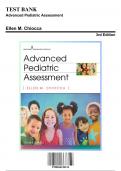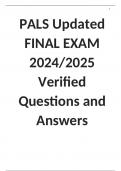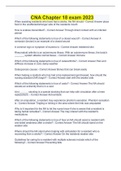Ellen M. Chiocca
TEST BANK
Advanced Pediatric Assessment
3rd Edition
9780826150110 Table of content
Chapter 1. Child Health Assessment: An Overview
Chapter 2. Assessment of Child Development and Behavior
Chapter 3. Communicating with Children and Families
Chapter 4. Assessment of the Family
Chapter 5. Cultural Assessment of Children and Families
Chapter 6. Obtaining the Pediatric Health History
Chapter 7. Assessing Safety and Injury Risk in Children
Chapter 8. The Pediatric Physical Examination
Chapter 9. The Health Supervision Visit: Wellness Examinations in Children
Chapter 10. Assessment of Nutritional Status
Chapter 11. Assessment of the Neonate
Chapter 12. Assessment of the Integumentary System
Chapter 13. Assessment of the Head, Neck, and Regional Lymphatics
Chapter 14. Assessment of the Ears
Chapter 15. Assessment of the Eyes
Chapter 16. Assessment of the Face, Nose, and Oral Cavity
Chapter 17. Assessment of the Thorax, Lungs, and Regional Lymphatics
Chapter 18. Assessment of the Cardiovascular System
Chapter 19. Assessment of the Abdomen and Regional Lymphatics
Chapter 20. Assessment of the Reproductive and Genitourinary Systems
Chapter 21. Assessment of the Musculoskeletal System
Chapter 22. Assessment of the Neurologic System
Chapter 23. Assessment of Mental Disorders in Children and Adolescents
Chapter 24. Assessment of Child Abuse and Neglect
Chapter 25. The Complete History and Physical Examination: From Start to Finish
Chapter 26. Formulating a Differential Diagnosis Advanced Pediatric Assessment Third Edition Test Bank Chapter 1. Child Health Assessment: An Overview MULTIPLE CHOICE 1. A nurse is reviewing changes in healthcare delivery and funding for pediatric populations.
Which current trend in the pediatric setting should the nurse expect to find? a.Increased hospitalization of children
b.Decreased number of uninsured children
c.An increase in ambulatory care
d.Decreased use of managed care
ANS: C One effect of managed care is that pediatric healthcare delivery has shifted dramatically from the acute care setting to t he ambulatory setting. The number of hospital beds being used has decreased as more care is provide d in outpatient and home sett ings. The number of uninsured children in the United States continues to grow. One of the biggest changes in healthcare has been the growth of managed care. DIF: Cognitive Level: Comprehension REF: dm 3
OBJ: Nursing Process Step: Planning MSC: Safe and Effective Care Environment 2. A nurse is referring a low-income family with three children under the age of 5 years to a
program that assists with suppl emental food supplies. Which program shoul d the nurse refer this family to? a.Medicaid
b.Medicare
c.Early and Periodic Screening, Diagnostic, and Treatm ent (EPSDT) program
d.Women, Infants, and Children (WIC) program ANS: D WIC is a federal program that provides supplemental food suppli es to low-income women who are pregnant or breast-feeding and to their children unti l the age of 5 years. Medica id and the Medicaid Early and Periodic Screening, Diagnostic, and Treatment (EPSDT) program provi des for well-child examinations and related treatment of medical problems. Children in the WIC program are often referred for immunizations, but that is not the primary focus of the program. Public Law 99-457 provides financ ial incentives to states to establish comprehensive early intervent ion services for infants and toddlers with, or at risk for, developmental disabilities. Medicare is the program for Senior Citizens. DIF: Cognitive Level: Application REF: dm 7 OBJ: Nursing Process Step: Implementation MSC: Health Promotion and Maintenance 3. In most states, adolescents who are not emancipated minors must have parental permission before: a.treatment for drug abuse.
b.treatment for sexually transmitted diseases (STDs).
c.obtaining birth control.
d.surgery.
ANS: D An emancipated minor is a minor child who has the legal competence of an adult. Legal counsel may be consult ed to verify the st atus of the emancipated minor for consent purposes . Most states allow minors to obtain treatment for drug or alcohol abuse and STDs and allow access to birth control without parental consent. DIF: Cognitive Level: Application REF: dm 12 OBJ: Nursing Process Step: Planning MSC: Safe and Effective Care Environment 4. A nurse is completing a clinical pathway for a child admitted to the hospital with pneumonia.
Which characteristic of a clinical pathway is correct? a.Developed and implemented by nurses
b.Used primarily in the ped iatric setting
c.Specific time lines for sequencing interventions
d.One of the steps in the nursing process
ANS: C Clinical pathways measure outcom es of client ca re and a re developed by multiple healthcare professionals. Each pathway outlines specific time lines for sequencing interventions and reflects interdisciplinary interventions. Clinical pathways are use d in multipl e settings and for clients throughout the life span. The steps of the nursing process are assessment, diagnosis, planning, implementation, and evaluation. DIF: Cognitive Level: Comprehension REF: dm 6 OBJ: Nursing Process Step: Planning MSC: Safe and Effective Care Environment 5. When planning a parenting clas s, the nurse should explain that t he leading cause of death in children 1 to 4 years of age in the United States is: a.premature birth.
b.congenital anomalies.
c.accidental death.
d.respiratory tract illness.
ANS: C Accidents are the leading cause of death in children ages 1 to 19 years. Disorders of short gestation and uns pecified low birth weight make up one of the leading causes of death in neonates. One of the leading causes of infant death after the first month of life is congenital anomalies. Respiratory tract illnesses are a major cause of morbidity in children. DIF: Cognitive Level: Application REF: dm 9 OBJ: Nursing Process Step: Implementation MSC: Safe and Effective Care Environment 6. Which statement is true regarding the quality assurance or incident report?
a.The report assures the legal department that there is no problem.
b.Reports are a permanent part of the clients chart.
c.The nurses notes should contain the following: Incident report filed and copy
placed in chart.
d.This report is a form of documentation of an event that may result in legal action.
ANS: D An incide nt report is a warning to the legal department to be prepared for potential legal action; it is not a part of the clients chart or nurse documentation. DIF: Cognitive Level: Knowledge REF: dm 14 OBJ: Nursing Process Step: Implementation MSC: Safe and Effective Care Environment 7. Which client situation fails to meet the first requirement of informed consent?
a.The parent does not understand the physicians explanations.
b.The physician gives the parent only a partial list of possible side effects and
complications.
c.No parent is available and the physician asks the adolescent to sign the consent
form.
d.The infants teenage mother signs a consent form because her parent tells her to.
ANS: C The first requirement of informed consent i s that the person giving consent must be competent . Minors are not allowed to give consent. An understanding of information, full disclosu re, and voluntary consent are requirements of informed consent, but none of these is the first requirement. DIF: Cognitive Level: Comprehension REF: dm 12 OBJ: Nursing Process Step: Implementation MSC: Safe and Effective Care Environment 8. A nurse assigned to a child does not know how to perform a treatment that has been prescribed for the child . What should the nurse s first action be? a.Delay the treatment until another nurse can do it.
b.Make the childs parents aware of the situation.
c.Inform the nursing supervisor of the problem.
d.Arrange to have the child transferred to another unit.
ANS: C If a nurse is not competent to perform a particul ar nursing task, the nurse must immediately communicate this fact to the nurs ing supervisor or phys ician. The nurse could endang er the child by dela ying the intervention until another nurse is available. Telling the childs parents would most likely increase their anxie ty and will not resolve the difficulty. Transfer to another unit delays needed treatment and would create unnecessary disruption for the child and family. DIF: Cognitive Level: Application REF: dm 11 OBJ: Nursing Process Step: Implementation MSC: Safe and Effective Care Environment 9. A nurse is completing a care plan for a child and is finishing the assessment phase. Which activit y is not part of a nursing assessment? a.Writing nursing diagnose s
b.Reviewing diagnostic reports
c.Collecting data
d.Setting priorities
ANS: D Setting priorities is a part of planning. Writing nursing diagnoses, reviewing diagnos tic reports, and collecting data are parts of assessment. DIF: Cognitive Level: Comprehension REF: dm 19 OBJ: Nursing Process Step: Planning MSC: Physiological Integrity 10. Which patient outcome is stated correctly?
a.The child will administer his insulin injection before breakfast on 10/31.
b.The child will accept the diagnosis o f type 1 diabetes mellitus before discharge.
c.The parents will understand how to determine the childs daily insulin dosage.
d.The nurse will monitor blood glucose levels before meals and at bedtime.
ANS: A The outcome is stated in client terms, with a measurable verb and a time frame for action. The verb accept is difficult to measure. The goal of accepting a diagnosis befo re hospital discharge is unrealistic. Outcomes should be stated in c lient terms. Nursing actions are determined after outcomes are developed in the implementation phase of the nursing process. DIF: Cognitive Level: Application REF: dm 20 OBJ: Nursing Process Step: Planning MSC: Safe and Effective Care Environment MULTIPLE RESPONSE 1. A nurse is reviewing the nursing care plan for a h ospitalized child. Which statements are
collaborative problems? Select all that apply. a.Risk for injury
b.Potential complication of seizure disorder
c.Altered nutrition: Less than body requirements
d.Fluid volume deficit
e.Potential complication of respiratory acidosis
ANS: B, E In addition to nursing diagnoses, which describe problems that r espond to indepe ndent nursing functions, nurses must also deal with probl ems that are beyond the scope of indepe ndent nursing practice. These are sometimes terme d collaborative problems physiological complications that usually occur in association with a specific pathological condition or treatment. The potential complications of seizure disorder and respiratory acidosis are physi ological complications that will require physician collaboration to treat. Risk for injury, altered nutrition, and fluid volume deficit will respond to independent nursing functions. DIF: Cognitive Level: Application REF: dm 20 OBJ: Nursing Process Step: Planning MSC: Safe and Effective Care Environment 2. Which nur sing activities do not meet the standard of care? Select all tha t apply.
a.Failure to notify a physician about a childs worsening condition
b.Calling the supervisor about staffing concerns
c.Delegating assessment of a new admit to the Unlicensed Assistive Personnel
(UAP)
d.Asking the Unlicensed Assistive Personnel (UAP) to take vital signs
e.Documenting that a physician was unavailable and the nursing supervisor was
notified
ANS: A, C A nurse who fails to notify a physician about a childs worsening con dition and delegating the assessment of a new admit to a UAP do not meet the standard of care. Calling the supervisor about staffing concerns, asking the UAP to take vital signs, and documenting that a physician could not be reached and the nursing supervi sor was notified all meet the standard of care. Chapter 2. Assessment of Child Development and Behavior MULTIPLE CHOICE 1. The nurse is performing an abdominal assessment on a child. When percussing over the
stomach, the nurse should hear which sound? a.Tympany
b.Resonance
c.Flatness
d.Dullness
ANS: A Tympany is a high-pitched, loud-intensity sound heard over air-filled body parts su ch as the stomach and bowel. Resonance is a low-pit ched, low-intensity sound elicited over hollow organs such as the lungs. Flatness is a high-pit ched, soft-intensity sound elicit ed by percussing over solid masses such as bone or muscle. Dullness is a medium-pitched, medium-intensi ty sound elicited when percussing over high-density structures such as the liver. DIF: Cognitive Level: Application REF: dm 170 OBJ: Nursing Process Step: Assessment MSC: Health Promotion and Maintenance 2. A nurse is preparing to begin an assessment on a newly admitted chi ld. The nurse should be aware that the single most important com ponent of a pediatric physical examination is: a.assessment of heart and lungs.
b.measurement of height and weight.






